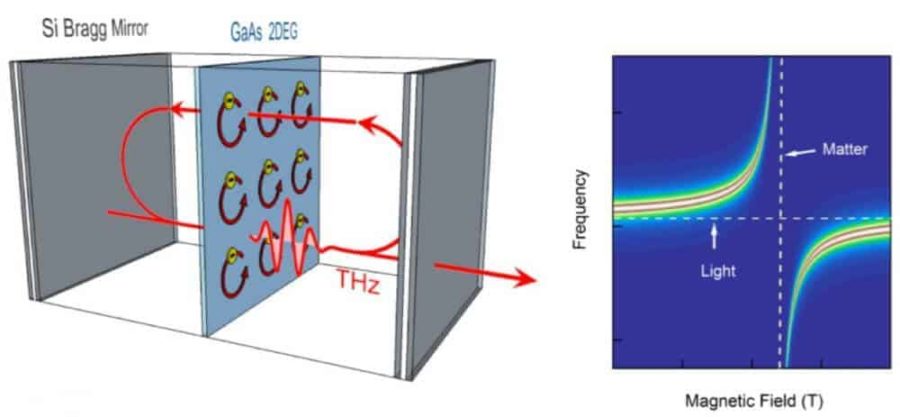Where light and matter intersect, the world illuminates. Where light and matter interact so strongly that they become one, they illuminate a world of new physics, according to Rice University scientists.
Rice physicists are closing in on a way to create a new condensed matter state in which all the electrons in a material act as one by manipulating them with light and a magnetic field. The effect made possible by a custom-built, finely tuned cavity for terahertz radiation shows one of the strongest light-matter coupling phenomena ever observed.
The work by Rice physicist Junichiro Kono and his colleagues is described in Nature Physics. It could help advance technologies like quantum computers and communications by revealing new phenomena to those who study cavity quantum electrodynamics and condensed matter physics, Kono said.
Condensed matter in the general sense is anything solid or liquid, but condensed matter physicists study forms that are much more esoteric, like Bose-Einstein condensates. A Rice team was one of the first to make a Bose-Einstein condensate in 1995 when it prompted atoms to form a gas at ultracold temperatures in which all the atoms lose their individual identities and behave as a single unit.
The Kono team is working toward something similar, but with electrons that are strongly coupled, or “dressed,” with light. Qi Zhang, a former graduate student in Kono’s group and lead author of the paper, designed and constructed an extremely high-quality cavity to contain an ultrathin layer of gallium arsenide, a material they’ve used to study superfluorescence. By tuning the material with a magnetic field to resonate with a certain state of light in the cavity, they prompted the formation of polaritons that act in a collective manner.
“This is a nonlinear optical study of a two-dimensional electronic material,” said Zhang, who based his Ph.D. thesis on the work. “When you use light to probe a material’s electronic structure, you’re usually looking for light absorption or reflection or scattering to see what’s happening in the material. That light is just a weak probe and the process is called linear optics.
“Nonlinear optics means light does something to the material,” he said. “Light is not a small perturbation anymore; it couples strongly with the material. As you change the coupling strength, things change in the material. What we’re doing is the extreme case of nonlinear optics, where the light and matter are coupled so strongly that we don’t have light and matter anymore. We have something in between, called a polariton.”
The researchers employed a parameter known as vacuum Rabi splitting to measure the strength of the light-matter coupling. “In more than 99 percent of previous studies of light-matter coupling in cavities, this value is a negligibly small fraction of the photon energy of the light used,” said Xinwei Li, a co-author and graduate student in Kono’s group. “In our study, vacuum Rabi splitting is as large as 10 percent of the photon energy. That puts us in the so-called ultrastrong coupling regime.
“This is an important regime because, eventually, if the vacuum Rabi splitting becomes larger than the photon energy, the matter goes into a new ground state. That means we can induce a phase transition, which is an important element in condensed matter physics,” he said.
Phase transitions are transitions between states of matter, like ice to water to vapor. The specific transition Kono’s team is looking for is the superradiant phase transition in which the polaritons go into an ordered state with macroscopic coherence.
Kono said the amount of terahertz light put into the cavity is very weak. “What we depend on is the vacuum fluctuation. Vacuum, in a classical sense, is an empty space. There’s nothing. But in a quantum sense, a vacuum is full of fluctuating photons, having so-called zero-point energy. These vacuum photons are actually what we are using to resonantly excite electrons in our cavity.
“This general subject is what’s known as cavity quantum electrodynamics (QED),” Kono said. “In cavity QED, the cavity enhances the light so that matter in the cavity resonantly interacts with the vacuum field. What is unique about solid-state cavity QED is that the light typically interacts with this huge number of electrons, which behave like a single gigantic atom.”

He said solid-state cavity QED is also key for applications that involve quantum information processing, like quantum computers. “The light-matter interface is important because that’s where so-called light-matter entanglement occurs. That way, the quantum information of matter can be transferred to light and light can be sent somewhere.
“For improving the utility of cavity QED in quantum information, the stronger the light-matter coupling, the better, and it has to use a scalable, solid-state system instead of atomic or molecular systems,” he said. “That’s what we’ve achieved here.”
The high-quality gallium arsenide materials used in the study were synthesized via molecular beam epitaxy by John Reno of Sandia National Laboratories and John Watson and Michael Manfra of Purdue University, all co-authors of the paper. Weil Pan of Sandia National Laboratories and Rice graduate student Minhan Lou, who participated in sample preparation and transport and terahertz measurements, are also co-authors.
Zhang is now the Alexei Abrikosov Postdoctoral Fellow at Argonne National Laboratory. Kono is a Rice professor of electrical and computer engineering, of physics and astronomy and of materials science and nanoengineering. Li received a “Best First-Year Research Award” from Rice’s Department of Electrical and Computer Engineering for his work on the project.


